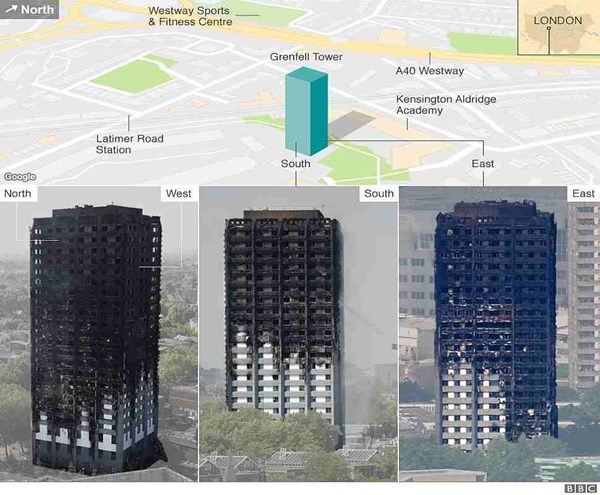The Grenfell Tower Fire - Let's make sure our architectural composites meet the codes
The devastating and deadly fire in a residential high-rise tower in London on June 14 did NOT involve composite materials as defined by CompositesWorld magazine, our readers and most composite suppliers.

Photos from the BBC show the extent of the fire damage in the Grenfell Tower (source: BBC News)
First, the devastating and deadly fire in a residential high-rise tower in London on June 14 did NOT involve composite materials as defined by CompositesWorld magazine, our readers and most composite suppliers. The Reynobond PE cladding panels that were involved in the fire, part of a “rainscreen” exterior installation (here’s a link to one of my articles from a few years back, where raincreens are discussed: http://www.compositesworld.com/articles/the-building-envelope-betting-on-the-big-time), were made of thin aluminum skins over a thermoplastic core, and manufactured by Arconic (New York, NY, US, the successor company to Alcoa Inc., which split into two entities in 2016 — Alcoa Corp. retains alumina, aluminum and bauxite production operations). Media reports say that a refrigerator placed close to an exterior wall might have been the fire source, and that the rainscreen air gap designed to keep rain out of the building instead acted as a chimney, funneling the flames that burned the decorative panels as well as the underlying Celotex polyisocyanurate (PIR) rigid thermal insulation. This is the latest in a succession of external cladding fires over the past 10 years, and there is good evidence that such cladding, if not properly fire tested, can spread fire externally on a building, both on the external cladding surface and within the cladding assembly, says Dr. Nicholas Dempsey, professor at Worcester Polytechnic Institute’s (Worcester, MA, US) Fire Protection Engineering department.
There are two big issues here, in my opinion. First, this cladding laminate obviously wasn’t fire retardant, and published reports including a New York Times article from June 24th (here’s the link: https://www.nytimes.com/2017/06/24/world/europe/grenfell-tower-london-fire.html) say it was installed inappropriately — that the aluminum laminates only “resisted” ignition, and in Britain regulators apparently did not require fire testing to evaluate flammability in as-installed conditions. US regulators don’t allow these and similar rainscreen cladding systems involving plastic above the height of a fireman’s ladder, about 4 stories, unless they pass the National Fire Protection Assn.’s (NFPA) 285 full-scale assembly test, as well as the ASTM E84 Standard Test Method for Surface Burning Characteristics of Building Materials and other tests, for compliance with US building codes.
The second issue is that the composites industry, which has the ability to provide façade materials compliant with International Code Council (ICC) International Building Code (IBC), Chapter 26 (Plastic) (we’ve written about one, the San Francisco Museum of Modern Art: http://www.compositesworld.com/articles/sfmoma-faade-advancing-the-art-of-high-rise-frp), has a responsibility to communicate with customers exactly what their materials can do in actual, as-installed situations, using actual fabrication methods — how fire resistant they are, the codes they comply with, the tests they can pass. And, suppliers should clearly label products with this information, in accordance with the building codes, so that architects and builders know with certainty what they’re getting, says architectural composites champion Bill Kreysler of Kreysler & Associates Inc.
Britain has, according to a June 25 article in The Guardian (https://www.theguardian.com/uk-news/2017/jun/25/revealed-60-towers-across-england-found-to-have-unsafe-cladding), 60 more housing high-rises with similar cladding. Architectural composites supplier Acell Industries Ltd. (Dublin, Ireland), about which we’ve written (http://www.compositesworld.com/news/smc-cladding-panels-preserve-pre-1919-building-aesthetics, for example) says it has a solution for this issue: for an affected building, remove the cladding, remove the underlying insulation, and wrap the insulation with its fire-resistant phenolic AMC (Acell molding compound) foam panels, which the company claims would protect the insulation from any fire in the cladding.
There are undoubtedly other fixes that our industry could supply. No matter how this plays out, we certainly don’t want to see a disaster of the Grenfell Tower scale happening in a building involving fiber-reinforced composites.
Related Content
Matrix Composite highlights carbon fiber SMC prepreg Quantum-ESC
Prepreg produced by LyondellBasell features high flow, rapid tool loading capabilities.
Read MoreAptera joins forces with C.P.C. Group to accelerate solar EV production
Specialized composite bodies are being produced in Modena, Italy, for Aptera’s BinC vehicle, enabling eventual manufacturing ramp-up of 40 vehicles/day to meet demand targets.
Read MoreDieffenbacher acquires Schmidt & Heinzmann composites business
The acquisition, which includes all intangible assets of the business unit, will expand Dieffenbacher’s SMC delivery spectrum, enable potential for portfolio growth and synergies.
Read MoreComposite materials, design enable challenging Corvette exterior components
General Motors and partners Premix-Hadlock and Albar cite creative engineering and a move toward pigmented sheet molding compound (SMC) to produce cosmetic components that met strict thermal requirements.
Read MoreRead Next
“Structured air” TPS safeguards composite structures
Powered by an 85% air/15% pure polyimide aerogel, Blueshift’s novel material system protects structures during transient thermal events from -200°C to beyond 2400°C for rockets, battery boxes and more.
Read MoreVIDEO: High-volume processing for fiberglass components
Cannon Ergos, a company specializing in high-ton presses and equipment for composites fabrication and plastics processing, displayed automotive and industrial components at CAMX 2024.
Read MoreAll-recycled, needle-punched nonwoven CFRP slashes carbon footprint of Formula 2 seat
Dallara and Tenowo collaborate to produce a race-ready Formula 2 seat using recycled carbon fiber, reducing CO2 emissions by 97.5% compared to virgin materials.
Read More






















